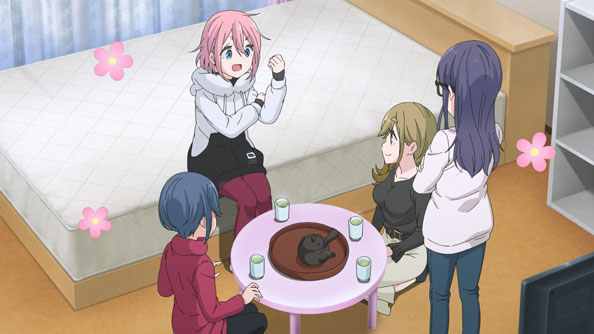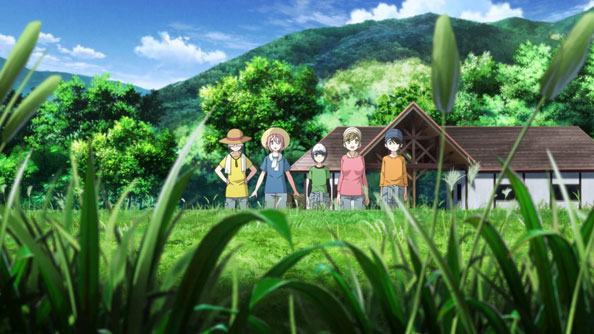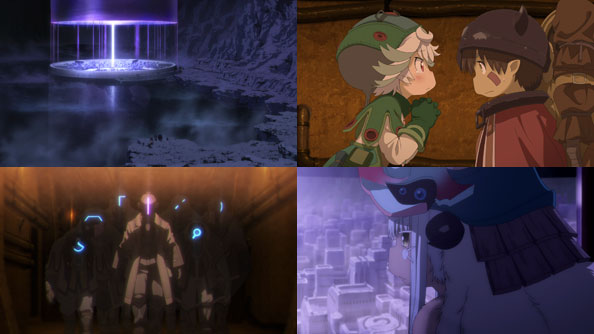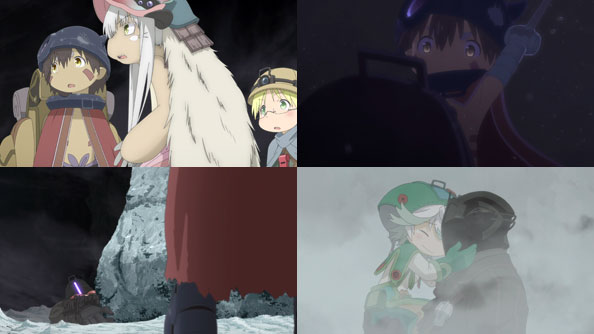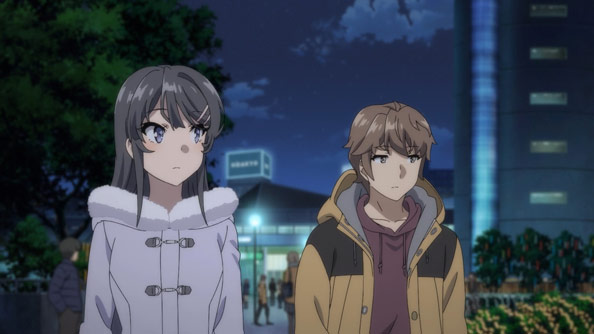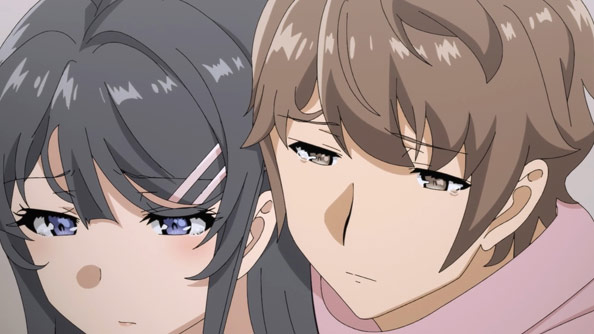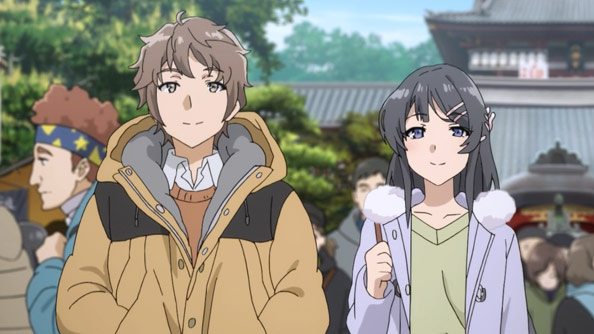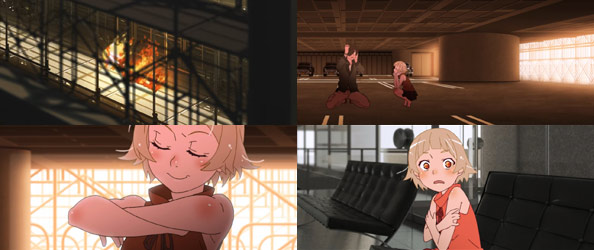In the prologue, Uesugi Fuutarou is in a wedding tux, summoned by the bride, only to find five identical brides: the Nakano quintuplets. Polygamy is as illegal in Japan as it is in the states, so what exactly is up here? Rewind to the eve of Fuu and the Quints’ final school festival. Fuu gathers them in a classroom and tells them he likes…all of them. However, he realizes he owes one of them an answer, and she’ll get that answer, at the end of the festival.
From there the narrative takes a non-linear approach, starting by showing each of the five sisters alone at the end of the third day, followed by an account of the festival from each of their points of view. Ichika, Nino, Miku, Yotsuba, and Itsuki all get some quality time with Fuu, and all of them (except Itsuki) manage to steal a kiss from him. During the festival, each sister steps forward.
Ichika with her acting career; Nino with her resentment of their distant doctor dad; Miku learns to be confident and assertive and mend fences between boy and girl classmates, and vows to go to cooking school; Yotsuba learns that sometimes she can be the one being helped rather than always helping; Itsuki rejects their asshole biological father who can’t even tell them apart, and embraces her dream of becoming a teacher like her mother.

Each of these segments represent both a summing-up and resolution to each of the girls’ arcs and points them forward. Indeed, each could have been its own episode in a third season. But when we come to the end of the third day and the movie throws every misdirection it can on who Fuu will go to, he ends up choosing…Yotsuba.
Yotsuba was “Reina”, the first sister Fuu met, and together they shared one of the happiest and most fun days of their young lives. But Yotsuba initially rejects Fuu, and it’s not him, it’s her who feels unworthy. The movie digs deep into Yotsuba’s past as the maverick of the quintet, the first one to differentiate her hairstyle with her green rabbit ribbon.
Yotsuba wanted to stand out from the crowd and be useful; this we know. But in trying to do so by joining (and excelling) at every club at school, she ended up flunking her exams, having to repeat her grade. When her father told her she’d be transferring to another school, the other four sisters said in no uncertain terms where she goes, they go.
Yotsuba runs from Fuu and his confession because she doesn’t feel she deserves to be “the special one” after trying to be just that in the past caused so many problems for her family. And yet, Yotsuba’s independent spirit was bolster by her meeting with Fuu, who like her wanted to work hard to become someone who was needed.

Even after calling herself “the best of the sisters”, the others had her back when she thought she’d cast away to be alone. When Fuu stumbles and falls and grabs Yotsuba’s ankle when he turns around to check on him, he tells her how much that day with her shaped him into the Fuutarou he is today. He chose her, he loves her, because she is special in that way to him. And when he asks directly, she can’t lie, she loves him too. She always has.
But just because Fuutarou loves Yotsuba and Yotsuba loves Fuutarou doesn’t mean they’re on easy street. Each of her four sisters reacts to it in different ways that suit their personalities. Ichika accepts her loss to Yotsuba, and now knows how Nino felt when she said she’d support her sister even if Fuu chose someone else.
Miku sings karaoke with Yotsuba all night, admits it’s hard to let go of Fuu, but ultimately gives her her blessing. Nino is the toughest, as one would expect. Always regarded as the strongest and sternest sister, the one who cared for everyone, even her older sister Ichika. She initially feels betrayed by Yotsuba for hiding how she felt until Fuu made a choice.
As Fuutarou and Itsuki are talking in a dark classroom, they have to hide when Nino and Yotsuba walk in to hash it all out. Ultimately, Yotsuba accepts that Nino can’t accept matters, at least not yet. But Yotsuba also assures Nino she won’t lose. In this context, Nino tells both her and Fuu to be on their guards; she’ll be watching, and if there’s any sign their love is false, she’ll swoop in and steal Fuu away.

A litte bit later, Yotsuba and Fuutarou have their first official date together, and it’s as adorably awkward and sweet as you’d expect. Fuutarou puts a lot of thought into the structure of the date, first taking her to a family restaurant where his family went, then to a library where he always studies, and finally to the playground where the two of them had a happy memory.
After Yotsuba takes a huge leap off the swing, Fuu attempts the same and ends up breaking the chain and falling on his face. But he rises to one knee and pledges to become a man worthy of standing beside her, and proposes marriage without a ring…on their first date.
Yotsuba points out he’s skipped a lot of steps, and warns that just about any other woman would probably hit the road…except her. By proposing to her, Fuu helped her remember another dream of hers: to become a bride. So while they can’t get married right away, she accepts his proposal.
Five years later, Ichika arrives back in Japan from her new home in America, Nino and Miku run their own café, and Itsuki is a schoolteacher. Yotsuba meets her sisters there and is all sweaty from riding the bike, even though the marriage ceremony is later that day. Their bridal gift to her is their mother’s diamond earrings, but they have to pierce Yotsuba’s ears so she can wear them.
The earrings are a sign of their collective love for her and blessing for her marriage. The momentary pain of the piercings are a reminder of the initial collective pain they felt when Fuutarou chose Yotsuba over them. With time, that pain has subsided. In the end, the quintuplets stuck together.

This brings us to the prologue of the film, in which Fuutarou is faced with five identical brides. Only unlike their asshole biological dad, and like their real date (Dr. Nakano), Fuutarou has long since been able to tell the five sisters apart. Fuu correctly identifying the sisters one by one is intercut with Yotsuba’s reception speech, where she thanks the sisters she loves so much for helping her become the woman she is.
Fuutarou then walks down the aisle with Yotsuba and puts a ring on her finger, and hey presto, a question two seasons and a movie in the making is finally answered. It was Yotsuba all along; the one who wrongly felt least deserving or worthy of Fuutarou’s love and favor. I for one couldn’t be happier.
And when it comes time for the honeymoon, naturally Yotsuba’s four sisters decide they’re coming along (though hopefully in separate, non-adjacent rooms). The only question is where they should go. On the count of three, the five girls point to five different spots on the map, just as they did years ago for their graduation trip. For all the ways they’ve changed and grown, they remain quintessentially quintuplets, and I loved each and every one of them.









